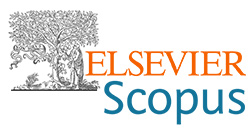Smanjenje sposobnosti upijanja vode papira oslojenih filmovima na bazi nanofibrilisane celuloze
DOI:
https://doi.org/10.5937/zasmat2103180MApstrakt
Nanofibrilisani filmovi na bazi TEMPO-oksidisanog pamučnog lintersa upotrebljeni su za smanjenje hidrofilnih svojstava papira. U tu svrhu su vodene disperzije nanofibrilisane celuloze različitog sastava: 1 i 3% nanofibrilisane celuloze, do 13% CaCO3 i/ili Al(OH)3, do 20% propan-1,2diol (glikol) i do 21% TEMPO-oksidisanih vlakana pamuka, nanošene na model papire, bez dodatka adheziva. Polazni i modifikovani model papiri sa oslojenim filmovima na bazi nanofibrilisane celuloze karakterisani su sa aspekta sposobnosti upijanja vode po COBB metodi i određen je ugao kvašenja. Izgled i hemijski sastav površine papira karakterisani su skenirajućom elektronskom mikroskopijom (SEM) i infracrvenom spektroskopijom sa Furijeovom transformacijom (ATR-FTIR). Pored toga, primenom odgovarajućih standarda određena su optička svojstva polaznog i modifikovanih papira (CIE lab koordinate, refleksija, CIE stepen beline). Zavisno od sastava disperzija, svi model papiri pokazali su određeno smanjenje sposobnosti upijanja vode, bez promena optičkih svojstava i morfologije površine papira u odnosu na nemodifikovani papir.Ključne reči:
nanofibrilisani celulozni filmovi, TEMPO-oksidisana celuloza, papir, sposobnost upijanja vode, ugao kvašenja, optička svojstva, morfologija površineReference
Banik, G., Brückle, I. (2011) Paper and Water: A Guide for Conservators Principle. Oxford: Elsevier Publishers
Brodin, F.W., Gregersen, Ø.W., Syverud, K. (2014) Cellulose nanofibrils: Challenges and possibilities as a paper additive or coating material: A review.Nordic Pulp and Paper Research Journal, 29(1): 156-166
https://doi.org/10.3183/npprj-2014-29-01-p156-166
Camargos, C.H.M., Figueiredo, J.C.D., Pereira, F.V. (2016) Nanocellulose for conservation and restoration of graphic documents: Experimental evidence. pp.14
Camargos, C.H.M., Figueiredo, J.C.D., Pereira, F.V. (2017) Cellulose nanocrystal-based composite for restoration of lacunae on damaged documents and artworks on paper.Journal of Cultural Heritage, 23: 170-175
https://doi.org/10.1016/j.culher.2016.10.007
Carter, H.A. (1996) The Chemistry of Paper Preservation: The Strengthening of Paper.Journal of Chemical Education, Part 3, 73(12): 1160-1167
https://doi.org/10.1021/ed073p1160
Castro, K., Pérez, M., Rodríguez-Laso, M.D., Madariaga, J.M. (2003) Peer Reviewed: FTIR Spectra Database of Inorganic Art Materials.Analytical Chemistry, 75(9): 214-221
https://doi.org/10.1021/ac031320e
Chang, P.S., Robyt, J.F. (1996) Oxidation of Primary Alcohol Groups of Naturally Occurring Polysaccharides with 2,2,6,6-Tetramethyl-1-Piperidine Oxoammonium Ion.Journal of Carbohydrate Chemistry, 15(7): 819-830
https://doi.org/10.1080/07328309608005694
Choukri, T., Michel, V. (2000) TEMPO-oxidation of cellulose: Synthesis andcharacterisation of polyglucuronans.Cellulose, 7: 177-188
https://doi.org/10.1023/A:1009276009711
Chung, C., Lee, M., Choe, E. (2004) Characterization of cotton fabric scouring by FT-IR ATR spectroscopy.Carbohydrate Polymers, 58(4): 417-420
https://doi.org/10.1016/j.carbpol.2004.08.005
de Nooy, A.E.J., Besemer, A.C., van Bekkum, H. (2010) Highly selective tempo mediated oxidation of primary alcohol groups in polysaccharides.Recueil des Travaux Chimiques des Pays-Bas, 113(3): 165-166
https://doi.org/10.1002/recl.19941130307
Eichhorn, S.J., et al. (2010) Review: Current international research into cellulose nanofibres and nanocomposites.Journal of Materials Science, 45(1): 1-33
https://doi.org/10.1007/s10853-009-3874-0
Hassan, A.E., Hassan, L.M., Oksman, K. (2011) Improving bagasse pulp paper sheet properties with microfibrilated cellulose isolated xylanase-treated bagasse.Wood Fiber Science, 42: 979-982
He, M., Cho, B., Won, J.M. (2016) Effect of precipitated calcium carbonate-Cellulose nanofibrils composite filler on paper properties.Carbohydrate Polymers, 136: 820-825
https://doi.org/10.1016/j.carbpol.2015.09.069
Honorato, C., Kumar, V., Liu, J., Koivula, H., Xu, C., Toivakka, M. (2015) Transparent nanocellulose-pigment composite films.Journal of Materials Science, 50 (22): 7343-7352
https://doi.org/10.1007/s10853-015-9291-7
Hospodarova, V., Singovszka, E., Stevulova, N. (2018) Characterization of Cellulosic Fibers by FTIR Spectroscopy for Their Further Implementation to Building Materials.American Journal of Analytical Chemistry, 9(6): 303-310
https://doi.org/10.4236/ajac.2018.96023
Isogai, A., Saito, T., Fukuzumi, H. (2011) TEMPO oxidized cellulose nanofibers.Nanoscale, 3(1): 71-85
https://doi.org/10.1039/C0NR00583E
Jiang, F., Yang, Y., Weng, J., Zhang, X. (2016) Layer-by-Layer Self-Assembly for Reinforcement of Aged Papers.Industrial and Engineering Chemistry Research, 55(40): 10544
https://doi.org/10.1021/acs.iecr.6b02988
Jin, L., Yanwei, W., Qinghua, X., Wenrun, Y., Zhengliang, C. (2014) Cellulose nanofibers prepared from TEMPO-oxidation of kraft pulp and its flocculation effect on kaolin clay.Journal of Applied Polymer Science, 131(12): 40450
https://doi.org/10.1002/app.40450
Jin, Y., Edler, K.J., Marken, F., Scott, J.L. (2014) Voltammetric optimisation of TEMPO-mediated oxidations at cellulose fabric.Green Chemistry, 16(6): 3322-3327
https://doi.org/10.1039/C4GC00306C
Kajanto, I., Kosonen, M. (2012) The potential use of micro and nano fibrillated cellulose as a reinforcing element in paper and board based packaging. in: TAPPI International Conference on nanotechnology for renewable materials, 2(6): 42-48
Korica, M., et al. (2018) Novel protein-repellent and antimicrobial polysaccharide multilayer thin films.Holzforschung, 73(1): 93-103
https://doi.org/10.1515/hf-2018-0094
Li, B., et al. (2015) Cellulose nanocrystals prepared via formic acid hydrolysis followed by TEMPO-mediated oxidation.Carbohydrate Polymers, 133. 605-612
https://doi.org/10.1016/j.carbpol.2015.07.033
Milanović, J., Lazić, T., Živković, I., Vuksanović, M., Milošević, M., Kostić, M. (2020) The Effect of Nanofibrillated Tempo-oxidized Cotton Linters on the Strength and Optical Properties of Paper.Journal of Natural Fibers, Published online: 24 December 2020
Milanović, J.Z., Milanović, P., Kragić, R., Kostić, M. (2018) 'Do-It-Yourself' reliable pH-stat device by using open-source software, inexpensive hardware and available laboratory equipment.PLOS ONE, 13(3): e0193744
https://doi.org/10.1371/journal.pone.0193744
Pereira, V.F. (2016) Nanocellulose-based composites for conservation and restoration of cultural heritage on paper: Comparative studies between traditional and innovative methods. in: TAPPI international conference on nanotechnology for renewable materials, Conference paper, 348-365
Praskalo, J., Kostić, M., Potthast, A., Popov, G., Pejić, B., Škundrić, P. (2009) Sorption properties of TEMPO-oxidized natural and man-made cellulose fibers.Carbohydrate Polymers, 77(4): 791-798
https://doi.org/10.1016/j.carbpol.2009.02.028
Qinghua, X., Weigong, L., Zhengliang, C., Gao, Y., Menghua, Q. (2014) TEMPO/NaBr/NaClO-Mediated Surface Oxidation of Nanocrystalline Cellulose and Its Microparticulate RetentionSystem with Cationic Polyacrylamide.BioResources, 9(1): 994-1006
https://doi.org/10.15376/biores.9.1.994-1006
Saito, T., Shibata, I., Isogai, A., Suguri, N., Sumikawa, N. (2005) Distribution of carboxylate groups introduced into cotton linters by the TEMPO-mediated oxidation.Carbohydrate Polymers, 61(4): 414-419
https://doi.org/10.1016/j.carbpol.2005.05.014
Saito, T., Isogai, A. (2004) TEMPO-mediated oxidation of native cellulose: The effect of oxidation conditions on chemical and crystal structures of the water-insoluble fractions.Biomacromolecules, 5(5): 1983-1989
https://doi.org/10.1021/bm0497769
Shen, J., Song, Z., Qian, X., Yang, F. (2010) Carboxymethyl cellulose/alum modified precipitated calcium carbonate fillers: Preparation and their use in papermaking.Carbohydrate Polymers, 81(3): 545-553
https://doi.org/10.1016/j.carbpol.2010.03.012
Stadler, A., Sage, D. D.Shape: Analysis. http://bigwww.epfl.ch/demo/dropanalysis/, 01.03.2021
Stalder, A.F., Melchior, T., Müller, M., Sage, D., Blu, T., Unser, M. (2010) Low-bond axisymmetric drop shape analysis for surface tension and contact angle measurements of sessile drops.Colloids and Surfaces A: Physicochemical and Engineering Aspects, 364(1-3): 72-81
https://doi.org/10.1016/j.colsurfa.2010.04.040
Taipale, T., Österberg, M., Nykänen, A., Ruokolainen, J., Laine, J. (2010) Effect of microfibrillated cellulose and fines on the drainage of kraft pulp suspension and paper strength.Cellulose, 17(5): 1005-1020
https://doi.org/10.1007/s10570-010-9431-9
Vohrer, U., Trick, I., Bernhardt, J., Oehr, C., Brunner, H. (2001) Plasma treatment: An increasing technology for paper restoration?.Surface and Coatings Technology, 142-144: 1069-1073
https://doi.org/10.1016/S0257-8972(01)01280-4
Völkel, L., Ahn, K., Hähner, U., Gindl-Altmutter, W., Potthast, A. (2017) Nano meets the sheet: Adhesive-free application of nanocellulosic suspensions in paper conservation.Heritage Science, 5(1): 23-30
https://doi.org/10.1186/s40494-017-0134-5
Yuan, B., et al. (2016) Transparent and flame retardant cellulose/aluminum hydroxide nanocomposite aerogels.Science China Chemistry, 59(10): 1335-1341
##submission.downloads##
Objavljeno
Broj časopisa
Rubrika
Licenca
Sva prava zadržana (c) 2021 CC BY 4.0 by Authors

Ovaj rad je pod Creative Commons Autorstvo 4.0 Internacionalna licenca.






